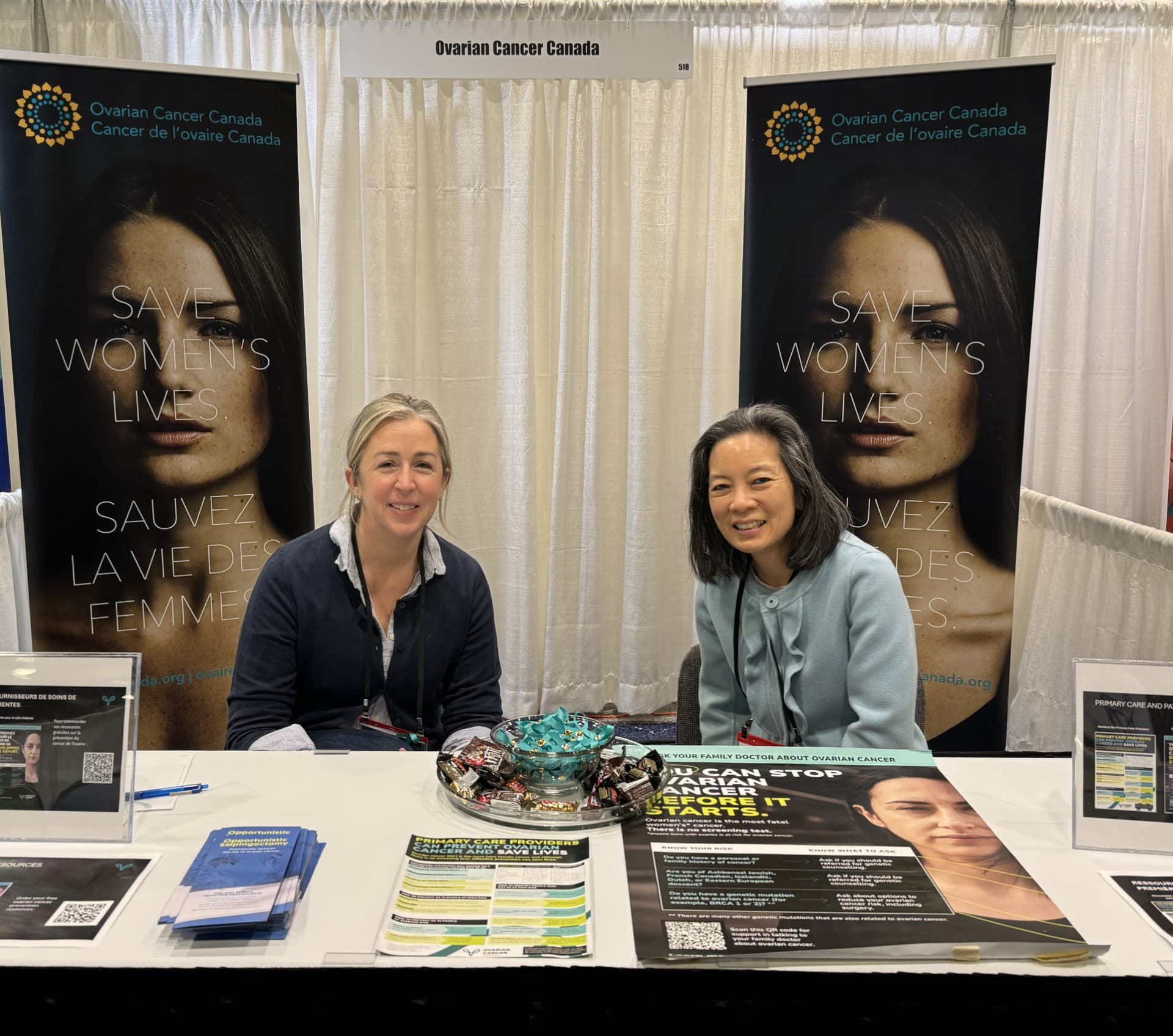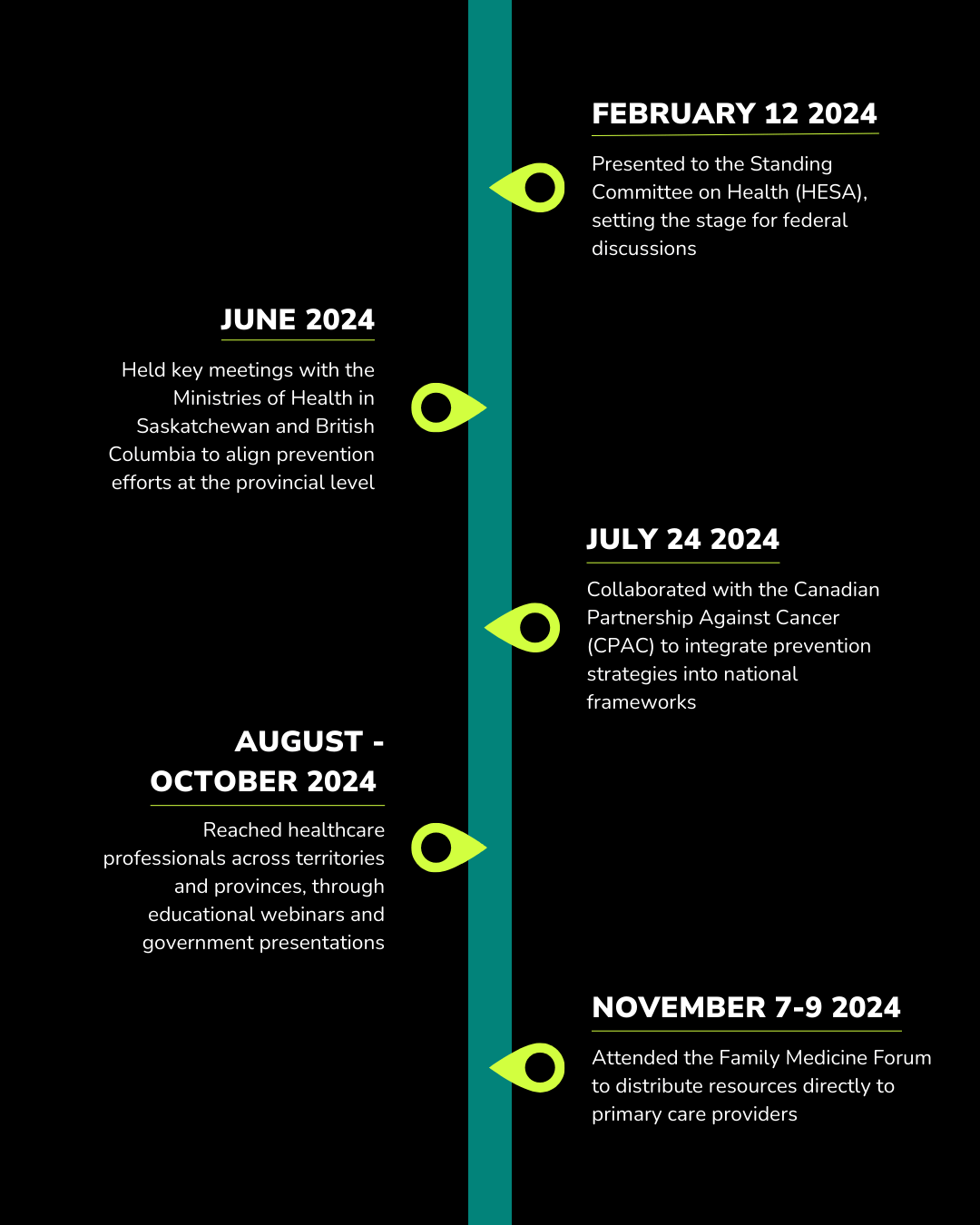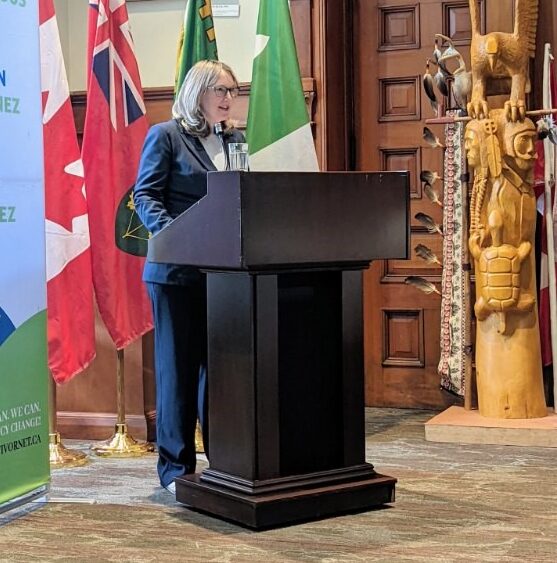In 2024, Ovarian Cancer Canada (OCC) established the Prevention Task Force, a team that combines patient, and scientific voices in the field of ovarian cancer research to take a bold approach to the urgent question: how can we prevent ovarian cancer on a larger scale? In our first year, we focused on addressing systemic gaps, identifying those at high risk of ovarian cancer, and empowering individuals at high risk to make informed choices about their health and understand the preventative options available to them.

Shanna Rice, Coordinator, Community Engagement and Events and Dr. Janice Kwon, member of the Prevention Task Force at the Family Medicine Forum
Laying the Foundation: Why Prevention Matters
Each year in Canada, 3000 people are diagnosed with ovarian cancer. Over half of those people will not live more than five years beyond their diagnosis, meaning that it is essential we identify opportunities to prevent ovarian cancer from occurring wherever possible. Prevention is the most powerful tool available to save lives from this disease today. The Prevention Task Force is one of the ways we’re addressing critical gaps in available support – ensuring that individuals at high risk have access to genetic testing, preventative surgical and non-surgical options, and education.
The Prevention Pathway
Our prevention strategy, designed by the Prevention Task Force, is rooted in a clear, actionable pathway. By identifying those most at risk and providing a clear path to address it, we can empower Canadians to make informed health decisions.
- Family history of ovarian or related cancers (breast, endometrial, colorectal, pancreatic, or prostate) on either side of the family
- Genetic mutations (such as in the BRCA1 or BRCA2 genes) in a close family member
- Ethnicity (for instance, those of Ashkenazi Jewish descent, French-Canadian descent, or Icelandic/Dutch)
- Timely referral to genetic counselling
- Testing for inherited cancer genes where appropriate
- Timely referral to gynecologic surgeons
- Pre-surgical consult, risk-reducing surgery, such as removal of fallopian tubes and ovaries, followed by comprehensive aftercare
Equipping Communities
After intensive deliberation, the Task Force developed patient-informed resources to ensure prevention is accessible and that people at risk understand their options:
- Clinical Guidelines for Primary Care Providers: These one-pagers outline the role of practitioners in assessing ovarian cancer risk and next steps for high-risk individuals
- Waiting Room Posters: Encourage individuals to consider their risk and initiate conversations with their primary care doctors
- Digital Tool: The Understand Your Risk tool helps individuals prepare for appointments with their primary care provider by identifying risk factors, family history, and potential symptoms relevant to ovarian cancer
The purpose of these tools is reaching as many people as possible, from previvors, clinicians, and government bodies, to those who have no knowledge of ovarian cancer risk. Their goal is to not only ensure that ovarian cancer remains a national priority but equip individuals and primary care providers with the knowledge to identify risk and make informed decisions.
Key Milestones: A Timeline of Progress
In its inaugural year, Prevention Task Force members spoke with key people across the healthcare system, leveraging every resource at our disposal and driving systemic change. Our collective efforts spanned from coast to coast.

BY YEAR’S END, THE TASK FORCE EMPOWERED 1,350 PEOPLE WITH THE UNDERSTANDING YOUR RISK TOOL, EDUCATED 279 DOCTORS AND NURSES ON OVARIAN CANCER PREVENTION, AND URGED NINE PROVINCIAL AND TERRITORIAL GOVERNMENTS TO MAKE OVARIAN CANCER A HEALTHCARE PRIORITY.
The Impact: Real Lives, Real Change
The Prevention Task Force’s first-year results are a testament to its effectiveness. As Cailey Crawford, our Vice President, Programs and Policy explains, “The Prevention Task Force has laid the groundwork for sustainable change, proving that ovarian cancer prevention can no longer be sidelined as too complex for our healthcare system to tackle.”

Cailey Crawford, Vice President, Programs and Policy speaks at the All Party Cancer Caucus in Ontario.
Looking Ahead
We are advancing systemic change and saving lives through prevention education, genetic testing, and access to risk-reducing options. In our first year, we have empowered at-risk individuals and mobilized the healthcare community to prioritize ovarian cancer prevention. Now, we are focused on building on this success and ensuring that ovarian cancer prevention remains a priority in Canada’s healthcare landscape.
“We have been hugely successful in spreading the word about ovarian cancer prevention,” says Alicia Tone, Director of Research at OCC. “At the same time, we have invested in promising research by Canadian scientists that aim to address key barriers along the prevention pathway. As these research projects are completed, we will see an even bigger impact on the number of ovarian cancers being prevented across Canada”
For more information, visit OCC’s Prevention Resources and Ovarian Cancer Risk Factors.
Video
HESA – Ovarian Cancer Canada on the need for increased research funding
Watch CEO, Tania Vrionis boldly urge the government to continue investing in transformative ovarian cancer research.
Video
Genetic testing can save lives
Learn from a genetic counsellor, as well as someone who has gone through genetic testing, about the important role of genetic testing in ovarian cancer prevention.


